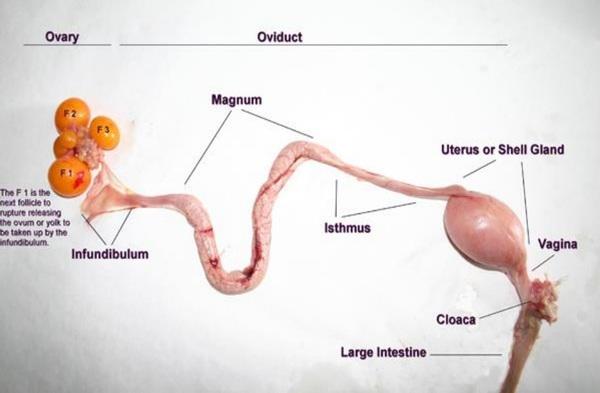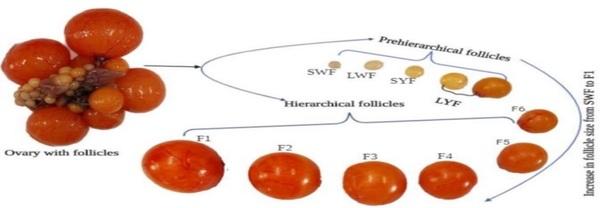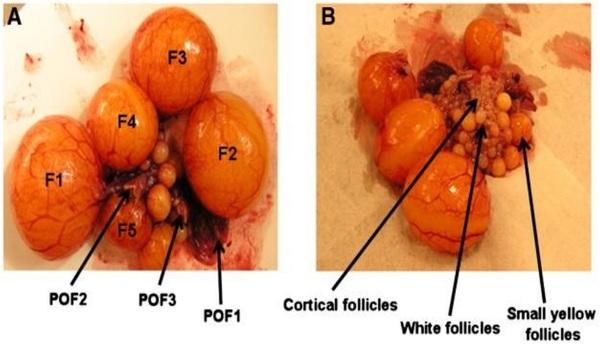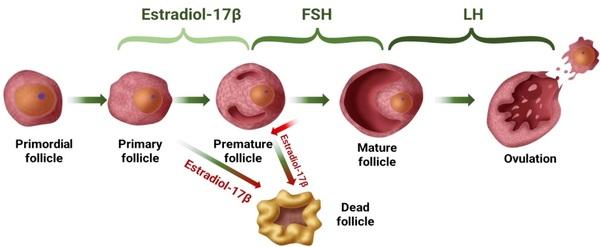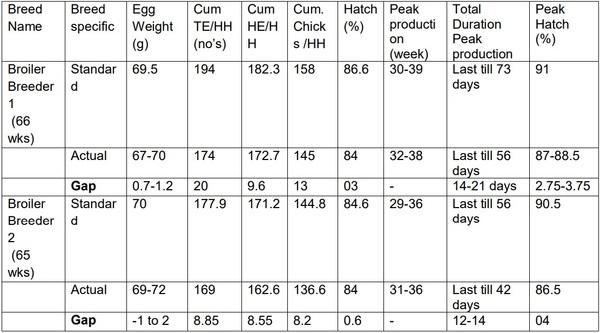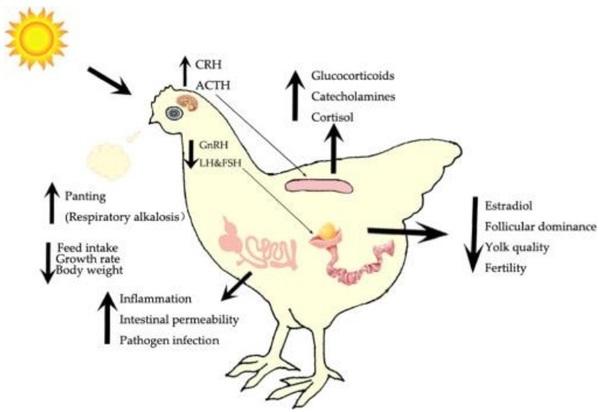INTRODUCTION
In the worldwide poultry industry, egg-laying production efficiency is a significant economic trait. Excellent productivity is measured by the number of ovarian follicles heading for ovulation and the efficiency of the oviduct to convert the ova into a hardshelled egg. But to increase number of ovarian follicles many factors are involved like Nutritional factors, Pathological factors, Managemental factors and Climatic factors. Before going to topic of available solutions to increase productivity of farm and match standard productive parameters, let us know about Anatomy and physiology of bird.
ANATOMY & PHYSIOLOGY OF CHICKEN REPRODUCTIVE SYSTEM
The reproductive system of a chicken hen is made up of two parts: the ovary and the oviduct.
Ovary develops many yellow structure pouches known as Ova (yolks). When an ovum (singular of ova) has matured, it is released from the ovary into the oviduct. This release of the ovum is called as ovulation (shown in Figure 1). The total time a hen’s body takes to transform a yolk into a fully developed egg and lay that egg is about 25 to 26 hours. Typically, about 30 to 75 minutes after a hen lays an egg, the ovary releases the next ovum.
Fig 1: Reproductive tract of laying hen
During egg formation process different parts of oviduct plays a role and finally egg formation takes place. Let us see different parts of oviduct and their functions.
FOLLICULOGENESIS IN POULTRY
Folliculogenesis is the development or maturation of the ovarian follicle which is densely packed somatic cells that contains an immature oocyte. This process outlines the succession of several small primordial follicles into large pre-ovulatory follicles which occurs in stages during the ovulatory cycle. Follicle development in the laying hen is characterized by a well-organized hierarchy (Fig 2).
Fig 2: Follicle hierarchy POF1, POF2 & POF3
The pre-hierarchical follicles are small follicle which are named based on size and they include.
1. Small white’ follicles (SWF; less than 1 mm)
2. Large white’ follicles (LWF; 2–4 mm)
3. Small yellow’ follicles (SYF; 4–8 mm) and
4. Large yellow’ follicles (LYF; 8–40 mm).
Hierarchical follicles are follicle before ovulation and are about 5–6 in number and above 10mm in diameter.
These follicles when reach to maturity will give mature ovulatory follicle which goes in egg formation.
However, follicular hierarchy is not observed in birds with lower reproductive efficiency. In case of chicken, left ovary is functional both physiologically and anatomically. The right ovary is present during embryogenesis, but the distribution of primordial germ cells to the ovaries of the chicken becomes asymmetrical by day 4 of incubation and starts regression by day 10 of the incubation. The ovary of immature birds consists nearly 2000 small ovas but only 200-500 reach maturity and are ovulated with in the production period.
Growth of Follicles:
The single left ovary contains follicles of various sizes and developmental stages including cortical primordial follicles, white follicles and large yolk-filled follicles (Fig 2) that have recruited to the well-ordered preovulatory hierarchy. Growth from 3 to 5 mm takes 3 days, from 5 to 8 mm 2 days and from 8 mm to ovulation (40 mm) 6 days (Gilbert et al. 1983), with the total time for development from 1·5 mm to 40 mm being around 17 days (Perry et al. 1983).Yolk formation occurs in the liver and is triggered by gonadotropin and steroid hormones. The yolk protein precursor, vitellogenin, is transported through the blood to the ovary, where it is cleaved into the two yolk proteins, lipovitellin and phosvitin (Deely et al., 1975). Triglycerides are transported to the yolk in the form of β- lipoproteins and later are assimilate into the yolk as lipid globules. Lipids and protein are deposited into the premature follicle with equal proportion for most of the growth phase, but during the final rapid growth phase, relatively more lipid is incorporated. The final composition of yolk in the hen's egg consists of a greater percentage of lipid (33% of wet weight) compared to protein (16% wet weight).
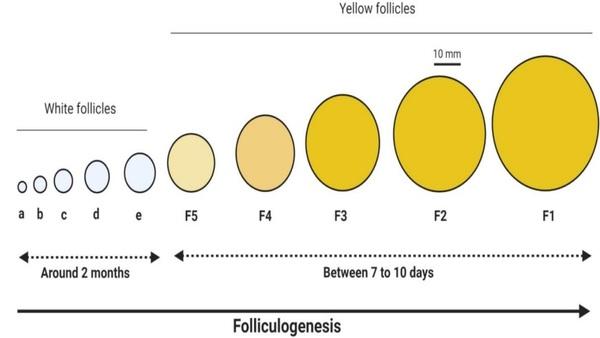
Fig 3: Sequence of Vitellogenesis
Hormonal regulation for follicle development
Follicle stimulating hormone (FSH) in the hen is responsible for the selection and granulosa cell development of the small follicles.FSH acts mainly on the granulosa layer of the tiny yellow and sixth (F6) to third (F3) largest follicles. It is also stimulating progesterone production in granulosa cells from F6 to F3 follicles. The Luteinizing hormone (LH) in hens does not luteinize the follicles, however it involved in ovulation and steriodogenesis. The primary target for the LH is larger preovulatory follicles (Fig 4).
Fig 4: Hormonal regulation for follicle development
Relationship between folliculogenesis and egg production
The broiler breed of different breeder (Table 1) is performing less in actual compared to breed specific standard which creates a significant gap between actual performance and breed specific standard. There are several challenging factors that make it difficult to bridge this gap.
Table 1: Different Broiler breeder specifications
This may be due to visible factors like climate, pathogens, nutrition, and management which are completely under the control of poultry entrepreneur. These factors play important role to breeder hen performance and are major key elements for successful broiler breeder farming. However, the foundation of these factors is completely depending on hidden factors like inadequate functioning of hormones and cell damage due to oxidative stress (Fig 5).
ROS decreased the layers’ reproductive performance as indicated by the lower egglaying rate, decreased hormone levels (including lower estradiol, FSH, LH), and by the smaller primordial follicle reserve and increased dead follicle in the ovaries of the challenged layers.
Fig 5: Factors responsible for oxidative stress
IMPORTANCE OF REPRODUCTIVE HEALTH
The profit in poultry breeder larger depend on reproductive health of the bird as it performs many functions, some of the functions are as below.”
1. Maturity of the bird is dependent on uniformity of flock which lead to development of reproductive organs.
2. Good reproductive health in poultry lead to optimum quality and quantity of egg.
3. Complete egg formation process happens in reproductive organs so reproductive organs health is important.
4. Hormones surge will be good if reproductive health is optimum.
5. Better reproductive health ensures lesser dead follicle and lesser non layer birds in flock and better Folliculogenisis process.
6. Poultry Reproductive system health is important to reduce clutch period.
